#why else would i have written so much smit
Explore tagged Tumblr posts
Text
I’ve said it before, but I’ll say it again: Clara Oswald has the cutest nose!
#doctor who#clara oswald#yeah i’m a clara oswald simp#why else would i have written so much smit#*smut#about her when i was 16?
7 notes
·
View notes
Text
Star Wars: The Clone Wars (Seasons 1--6), Final Analysis

Well, I made it through.
Let’s be absolutely clear: The Clone Wars (TCW) is not good television. For the most part, it’s not even watchable television. The show suffers from serious fundamental issues in nearly every aspect of storytelling. Characters are underdeveloped and inconsistent; the dialogue is expository and contradictory; the tone is disjoint and jarring; and most episodes serve no greater purpose than to be a twenty-minute vessel to house lightsaber fights.
So I want to put this part of the show to rest before I move on to Star Wars: Rebels (and before returning to watch season 7).
With two exceptions, the show poorly handles twists and reveals. In the earlier seasons, reveals were spoiled mostly due to telegraphing: Captain Sleaze in Cloak of Darkness, Senator Clovis in Senate Spy, and Yolo (?) in Senate Murders come to mind, but there were others. In later seasons, telegraphing was supplanted by “small universe syndrome” as the primary cause of spoiled reveals. In The Academy, a cloaked figure was seen doing shady, back-alley deals, but his identity could only have been the Prime Minister. During the “Ahsoka framed” series, Barriss was obviously the traitor, simply because her character suddenly reappeared after four seasons and there were no other candidates.
Probably the most successfully executed reveal was that of Krell, as his assholeness was at least initially masked as military rigidity. But even so, it was so over-the-top that when the reveal finally came to light, it felt more like an overdue disclosure than a dramatic twist. It didn’t help that, by that point in the show, the format of “asshole = upcoming reveal” had been firmly entrenched into the show’s DNA.
I would argue that the most effective plot twist of the entire show was when the dancer/singer girl shot and killed Ziro the Hutt in Hunt for Ziro. Although irrelevant to the greater story, it was an actual twist because it was strongly implied the opposite would happen (i.e., Ziro would betray the girl). If there is to be a second place, that award would go to Ahsoka’s decision to leave the Jedi Order at the conclusion of The Wrong Jedi. But this leads me into my next point...
Who was the main character of The Clone Wars? If we go by the logic that whoever had the most screen time was the main character, then Anakin probably wins over Ahsoka. But if we go by the logic that the most developed character was the “main character,” then this is a show about Ahsoka. Ahsoka---more than any other character---grows in a noticeable way (from impatient, violent child to impatient, slightly less violent teenager). In contrast, Anakin in Rising Malevolence is the same character as Anakin in Voices (only a little more violent and angry for some reason).
It’s unfortunate that her major character moments were never capitalized on. Intentionally sacrificing herself for the greater good in Weapons Factory apparently led to no lasting repercussions on her character. Her impatience and disobedience led to the deaths of thousands in Storm over Ryloth, but was similarly forgotten immediately afterwards. Even Ahsoka’s major character moment at the end of The Wrong Jedi resulted in her walking away from the show, never to address the implications of that decisions (although I suppose that’s the subject of Season 7).
On a different note, the show was riddled by a shameful amount of “references” and fan service, for reasons exclusively external to the story. These “nods” ranged from the obvious “Obi-wan Kenobi, you’re my only hope” (or whatever Senator Jimmy Smits says in Cat and Mouse) to the innocuous design of a droid or background device.
These “references” are objectively problematic for at least a few reasons. (1) They contribute to the sense that the universe is a really, really small place. Is the Mos Eisley cantina really the only place in the Outer Rim where shady deals go down? Is carbon freezing really the only way to store a person in stasis for transport? How long do Rodians live for anyways? Greedo’s gotta be what, like 80 when Han shoots him in A New Hope? It’s ironic that ultimately, this incomprehensibly large, diverse galaxy actually feels much smaller after watching this series because we keep going to the same twelve places...
(2) “Fan service” is tricky to get right because different people have different memories and impressions of the source material. In result, copying material will oftentimes comes across as a blatant misunderstanding of the original content. For example, to me, Vader put Solo into carbon freeze because it’s what Lando had lying around. It’s not a galactically established method of transporting people. Obi-Wan trained Luke with those laser balls aboard the Falcon because Han had them lying around and Obi-Wan needed to improvise a training exercise to kill time.
(3) "References” and “nods” usually are just a band-aid for a lack of creativity. Some of the better episodes in the initial seasons were just direct rehashes of famous movies. Seven Samurai, Godzilla, Stray Dog, The Most Dangerous Game, King Kong... I mean, it’d be pretty impressive to mess-up stories like these, but it’s concerning that there were just so many episodes made from other people’s stories.
These “references” even seep into the most innocuous of scenes. When Prequel!Wan lands on Mandalore to attempt a rescue of Satine from Darth Maul, one of the Mandalorians takes aim at him, only to have their blaster pushed down by their companion who’s shaking their head. This is a direct reference o the Tusken Raiders on Tatooine when Luke went after R2 in the desert. Even if this scene served an important plot purpose (it didn’t), there’s undoubtedly a multitude of ways to communicate the same thing. Instead, a small reference to the OT is interjected into the show, deimmersing the audience from the events shown. Unfortunately, this is just one (very small) example of hundreds over the whole show.
Let me say something positive. The episodes that worked best (especially early in the show's run) were ones that focused on mortal people, usually the clones. Innocents of Ryloth was one of the first watchable episodes, simply because we didn't have to sit through twenty minutes of unlikable, unrelatable “Jedi” and instead followed around a pair of troopers helping a little girl using their limited abilities. Likewise, Pursuit of Peace was way more enjoyable than it probably should have been, simply because the story was understandable, the consequences clear, and the drama real. Plan of Dissent (when the clones actively rebel against Krell) was also noteworthy for similar reasons: clones we liked must subdue a “Jedi” we’ve learned to hate.
This isn’t to say that episodes focused on the major characters were inherently unenjoyable, it’s just that none of these characters had any room to grow (with the exception of Ahsoka). Dooku, Grievous, Anakin, Prequel!Wan... They were the same characters as portrayed in Episode II and III. As presented, there was nowhere for these characters to go. Dooku was literally identical at the beginning of the series as he was at the end, and the same can be said about the others.
But these are false constraints the writers imposed upon themselves. Grievous was not in Episode II and was introduced in Episode III. TCW could have started him however they wanted and then illustrated his change into the character he later becomes. Who was he? What was his motivation? Why did he hate Jedi so much? The show was handed a completely clean slate to deliver a character from scratch, but instead we were immediately shown “Episode III General Grievous” with zero introduction because fans were expected to already know who he was.
This is partly why the backstory episode to Grievous was so compelling, at least in premise: viewing his home was personal to his story and it represented a chance to learn a bit more about the character and where he came from. Of course, it was mostly mishandled by a reliance on meaningless action, but the high ratings of that particular episode suggest there was room for quality television here, it just was never capitalized on.
Instead, we have completely static caricatures, especially for minor characters from the movies. Admiral Tarkin, Admiral Ackbar, Greedo (among others) were written out of cardboard and their roles in the plot could have just as easily been played by anyone else (there was nothing unique about their roles that required them to be these characters).
This is a shame because a lot could have been done with the established premise to really focus on Anakin, his motivations, and his relationship to his Padawan. I would have been okay with a lot of backtracking if it meant I could begin to grasp his “fall” to the Dark Side. Instead, I’m honestly more confused than ever about his motivation.
One argument is that Anakin joins the Dark Side because he like, “loves” Padme (or whatever). However, what we’re shown in this show---consistently, clearly---is that Padme and Anakin have a toxic, dysfunctional relationship. He is uncomfortably jealous and rarely trusts her. They argue nearly every time they’re together. Their “love” (or whatever) must remain secret, equating their relationship to something “wrong” or even “illegal” that must be kept secret, even on the verge of death. In a later episode, Anakin orders Padme to listen to him because he’s the “man” and, as his wife, she doesn’t have a say in the matter. This is clearly a broken relationship and the best result is the one that actually happens: They stop seeing each other. Anakin wants to save this woman from a vision? Why?
This brings up a second point, which is that Anakin can’t stand the pain of losing someone. His desire to protect those close to him may be Anakin’s only redeeming trait. He has a single selfless scene (in the entire show) during the opening of Jedi Crash where he sacrifices himself to delay an explosion and save his companions. I want to stress that any other scene where Anakin saves or helps someone isn’t done because he’s a good person, it’s done because he’s a broken person. It’s done because he, personally, would struggle with the emotional toll of knowing he allowed someone close to him to be hurt or die. In other words, he’s doing nice things for selfish reasons.
As far as I’m concerned, Anakin has always been Darth Vader. He is given choices between being a Jedi and allowing a lot of people to die, and he enjoys choosing the second. In Ghosts of Mortis, we’re shown that the threshold between “Anakin” and “Darth Vader” is disconcertingly low, requiring only a few choice words and less than a minute to convert him. In short, what I’ve learned from TCW regarding Anakin Skywalker is that he was an unlikable dick, and his “turn” to the Dark Side was just a long-overdue reveal.
While the later seasons worked towards the events in Episode III in a way that at least made a bit of sense, earlier seasons were focused on adult-themed wacky hijinks. In a way, the show almost would have worked better as a kid’s show, but this was clearly meant for adults: politics, war, slavery, and lots and lots of horrific violence. In comparison, the silly adventures of Star Wars: Resistance worked well because the show didn’t take itself too seriously. It was very clearly, from the start, a lighthearted show about kids going on fun adventures. In contrast, TCW suffered because its themes were adult in nature, but was portrayed as a Saturday morning cartoon show. The humor was misplaced, the tone disjointed from actual events, and the violence excessive.
Let me say a few words on the “Jedi.” Initially I labeled them as overpowered (OP), because in earlier episodes they seemed invincible and dissolved tension in every scene. Later, we see a slew of them get cut down as plot fodder, even against widely different situations. We see Luminara and others push through hoards of droids only to see “Jedi” Master Yoda-like dude get taken down by a dog. We watch as Fisto *heh* powers through entire battalions and the cone-head guy counting coup against an army, only to watch as pink girl gets shot in the face by a single clone who stands in front of her for several seconds before pulling the trigger.
It’s nearly impossible to feel tension in these scenes because the metrics for judging the true strength of a “Jedi” keep shifting as a function of the plot requirements. Anakin suddenly forgets how to use the Force when the plot needs his help to fake some drama. Prequel!Wan pointlessly fist fights with a slaver cat for an hour until the plot needs him to get back up again and OP everyone in the room. Even their ships are only as strong or weak as the plot needs them to be. Plo Koon’s fleet is devastated in seconds in order to portray the Malevolence as being a threat; Anakin’s fleet powers through a larger force three times its size because Anakin’s like, really mad about something.
Secondly, the “Jedi,” in general, were unlikable assholes. They were consistently portrayed as violent and ignorant and I struggled to understand them as real people. Frequently, we witnessed them torture victims, default to a lightsaber to solve problems, and enjoy death to the point of counting coup against sentient life forms defending their homes. Anakin threatened civilians with his lightsaber. Ahsoka was annoyed when she’s asked not to murder a defenseless creature in Jedi Crash. Prequel!Wan and Anakin team up to hurtle enormous rocks into a beaten monster in Dooku Captured. A trio of Jedi Masters mentally gang bang a shackled Cad Bane. They supported state terrorism when it suited their needs, but agreed to abandon their friends for political reasons.
I mean, these are not good people...
This is a shame, because my impression of true Jedi comes from Luke, Yoda, and Obi-Wan in the OT, as well as the expanded universe novels that take place afterwards. It always seemed to me that being a Jedi was about conquering oneself, one’s fears, and learning to use the Force to selflessly help others and let go of all worldly attachments. You know, like the Buddhists they were originally inspired by. I always had the impression that the Force was extremely powerful and that Yoda was only showing Luke a portion of what was possible. That the Emperor was only using Force lighting to toy with Luke. That Vader only Force choked his officers because it was visually intimidating and kept them in line.
Instead, we’re treated to some garbage about how a “Jedi” is nothing greater than an actuator to swing around a lightsaber. When Luke enters Jabba’s palace in Jedi to rescue his friends, it’s not with lightsaber swinging, cutting shit up, flipping around like an acrobatic monkey. Imagine Anakin and Ahsoka in the same scene. They’d blaze through the palace corridors before Force choking Jabba as the Darth Vader theme plays. Forget the rancor, these are demigods. They have lightsabers. Have you seen them? They go “woosh woosh.”
In short, there was little to look up to in terms of a “hero” character. I can see how children can look up to Luke as a role model, someone they want to emulate or play with as a toy, but looking up to Anakin? Ahsoka? Hey kids, wanna learn to become a psychopath? First, you use your power to abuse those who are weaker than you. Then you need to get really really angry and uncontrollably choke someone, preferably your sister or one of your cousins.
And so, for a Saturday morning cartoon show, it is very unclear who we’re supposed to care about. I liked when Ahsoka went against Anakin because I hated his character so much. I liked everything with Hondo, a pirate. I liked Ventress a little, because she was actively seeking to kill the main characters. I liked some of the clones, but I don’t know which ones because they all looked the same. I cared about Darth Maul because I’m honestly a little worried about him, especially after the loss of his brother. I kinda liked General Grievous just because he hates the “Jedi” and was therefore relatable (even though the reasoning was never explained). And... that’s it.
At no point did I ever “look forward” to the next episode. I painfully died a little on the inside hitting the “watch next” button every single time.
This “review” is already way too long, so let me summarize by applying my five-star rating system (developed for movies) to each episode. In review:
5. Amazing, classic, culturally important. Something everyone should watch. 4. Great; very well done, no significant flaws. 3: Entertaining with only minor gripes/criticisms. 2: “Watchable,” but suffers from flaws and has some poor parts. 1. Uncomfortably bad; suffers from serious flaws. 0. Painfully bad, would actively fight against being forced to watch a second time.

The 3-star episodes were:
Hostage Crisis
Lightsaber Lost
Pursuit of Peace
Carnage of Krell
The Wrong Jedi
Hostage Crisis was the introduction of Cad Bane, Lightsaber Lost was the remake of Stray Dog (and the only episode to include a real Jedi), Pursuit of Peace was the random Padme/politics episode that was strangely well-executed, Carnage of Krell was the reveal of Krell as a bad guy and his clones working to apprehend him, and The Wrong Jedi was Ahsoka leaving the Jedi Order (and the only episode to include a true character moment).
Also, I scaled the IMDB ratings of each episode to my ratings and then detected outliers in their overlap. In other words, I wanted to answer the question, “which episodes did I rate the most differently from others?”
Turns out, I rated every single episode lower except for seven. Those seven were:
Mercy Mission (+1.853) - R2 and 3PO discover an underground world with ents. This one is universally panned by “fans,” but was a competently handled episode apart from the disappointing resolution.
Pursuit of Peace (+1.382) - Padme struggles to win support for a Senate bill. Another competently handled episode that focuses on Padme and politics and is ranked low by “fans.”
Lightsaber Lost (+0.6471)
Weapons Factory (+0.4118) - An average episode with a dramatic scene of sacrifice by Ahsoka and her “friend” Barriss.
Shadow Warrior (+0.3824) - Grievous is captured during some dramatic moments on Naboo.
Hostage Crisis (+0.3529)
Front Runners (+0.0882) - One of the rebels episodes, I don’t remember which.
In conclusion, Star Wars: Rebels is next and I am somehow still alive.
16 notes
·
View notes
Text
Mango Love - Krii7y
It was a normal noon at College, Students wondering around campus paying little to no attention to their surroundings some sipping drinks, readings a text book in prep of a test the next day, talking and hanging with friends or just looking at their phone. The weekend was around the corner.
"John, get out here already we're gonna be late for the gathering Jesus!" yell a ready to go Craig. Their friend Vanoss decided they should have a get together, all the guys have been busy with either their jobs or classes so he suggested they meet up at his dorm and have a 'Guys night'. Which just meant they were probably gonna get a tad drunk and play random games. "I’m coming don’t get your dick in a bunch." John replied trying to fix his tanium hair in the bathroom mirror. He had thrown on a random blue flannel and a white shirt with ripped jeans, light baby blue nail polish tacked on his nails. Once satisfied with his look John walked outta the bathroom straight to the corner of the room near the couch were they toss their shoes. Craig was waiting rather impatiently at the door with their part of the refreshments they were meant to bring to the gather. They all had to bring at least one kind of item to the dorm, rather it be drinks a game or even random party supplies such as silly string. They all planned to stay the night at Van's dorm so they could do what ever they wanted without the need of going back to their individual housings.
As John kicked on a pair of short heeled boots he stood to face the man tapping his foot in annoyance of the wait. "Johnny Boy looking rather nice for heading to a dorm room with Assholes." Craig snickered and he looked at his friend's clothing then looking him in the face with a smirk. "Who you trying to impress, the walls?" he said raising his eyebrow at John as John rolled his eyes. "I mean the walls are pretty cute." he joked along side Craig. "Yeah Yeah, But really whats with the niceness of-" he said waving his hand at John's attire "this?". "Well if you MUST know, ya snoopy prick, Smits gonna be there." John replied matter of fact-ly. Craig chuckled at him and just waved him to the door knowing wasting anymore time would make them late. They grabbed their share of drinks and headed out the room, talking slightly while walking to their friends dorm which was on a higher floor of build.
On the Walk Craig Teased John a little for why he was dressed nice. Knowing fully well the nail polish sporting male fancied the Slight Younger guy that goes by Smit. Smit never went by a real name and all teachers and class mates called him 'Smit' or 'Milky Boy' as his friends say. John didn't mind the slight teases, joining in on some just for the hell of it. On the way to their destination they met half way with a few of their friends. Ohm and Cartoonz were the first they ran into while heading to the elevator. They had bought a load of Silly String with Light snacks, they went on about how they were gonna try and make a silly string mask while one of the others were asleep. Next was Tyler who was a floor above them, sporting Vodka glasses. Jiggly, Scot, and Marcel had a bunch of random things, Marcel and Scot had to call jiggly to help carry some of their stash which is how they ended up meeting the others. Delirious, Moo, Nogla and Terroriser were already in the dorm setting up when the others arrived.
-
It was around 8 pm when they all had everything set up; Games in the small living roomish area on their coffee table, Drinks and Alcohol in the Mini Kitchen, Snacks on the Counter scattered out and every other Random thing brought in a bag on the floor next to the couch. Craig went off with Vanoss to the hallway outside the room to order pizza after getting everyone's request written on a little sticky note. Smit had yet to arrive to Johns disappointment, He had Texted Vanoss explaining he was gonna be late to which he told the rest. In the dorm room Thing were slightly starting to kick off, Nogla declared a uno battle between Him Ohm Terroriser and Moo, The losers had to down 1 shot of Vodka each. The other guys just stared at the 2 settings up an uno game, some of the guys brought their laptops for games as they did have them for a reason.
Just as the first round of Uno , that didn't happen to last long, came to a end Vanoss and Craig walked back in with a third head to the pair. Everyone turned to the door besides the 4 on the ground who were laughing at Ohm who lost the round for him and Terroriser due to ohmming it. Smit pushed through the 2 standing in front of him which only caused them to giggle, He slightly yelled 'Yeet' while holding up 2 bottles of Mango Rum. Everyone joined in on the giggling. Smit was no taller than most of the group, being the shorted one by far, which made his small self look like a kid who just won a prize. John stared at the male and just smiled slightly to himself. Smit noticed him and laid the drinks on the counter, then happily walked over to his friend.
After Ohm and Terroriser downed a shot each Terroriser yelled at Nogla for a rematch. The rest of the guys booted up their laptops and got on scribbl.io. After a few more rounds of those games the pizza had arrived, Hearing a knock at the door Vanoss offered to get it seeings how everyone else was to busy with their yelling to even notice. Getting the pizza and laying it on the table Vanoss proceeded to yell at the guys in his living room that dinner was here and if they didn't come get it then it's their fucked. John jumped up from his spot on the couch where him, Smit and Craig had took to play their rounds. Smit watched him get and followed shorty after, Craig the last to get off the couch as it was his turn in Scribb.io.
While eating pizza, Smit got up and asked someone if they wanted some of that rum he brought. John Shook his head as the others either declined or said they'd get some after they ate. Shrugging off the replies, Smit walked to the counter and grabbed to small glasses for him and John. John watched Smit has he pored the drinks, enjoying the site of his friend and to one level crush. Getting lost in thought he almost completely looked over the fact Smit had caught him gazing over his direction. Craig noticed John's lost-but-lovingish stare at Smit, like a Dog with his favorite toy, and couldn't help but chuckled. He Nudged John who popped outta thought and noticed Smit was smiling and staring back at him, He felt his face become slightly more heated.
Smit returned with the drinks and giggled at a blushing John, which didn't help John, next to him. Handing him his drink and retraining the conversation he was having with Craig before leaving. John couldn't help but feel embarrassed at being caught in a gaze Come on John knock it off he mentally slapped himself. John had had a thing for the white haired kid for a while, they met in a class they shared start of semester. A class John would skipped but went to just to see and talk to him. They became friends over a common interest of video games and slight fashion tastes, John introduced him to Craig who he shares a dorm with when He first invited Smit over. Smit had transferred from Canada for a certain program he had to take for Design, which was what caught John's interest at first. Over the months of them hanging out and playing a few games together John noticed how much he had fallen for the boy.
John was lost in thought once more and subconsciously sipped his drink, the rum burning his throat as it went down but he didn't notice. Smit had saw John who was staring sorta at him but off to the window that was just to the other side of Smit while leaning slightly on to his shoulder. He tried to get John's attention while trying to keep him on his shoulder, he liked the slightly comfort john leaning on him gave, he wasn't gonna lose it just to knock him outta his daze. John popped back into reality once he felt someone nuzzle their nose into the crook of his neck.
John blushed wickedly hard as he noticed where the affection was coming from, Smit didn't remove his face from that position, finding it rather nice and soothing. The Mango rum started to settle in once he came back to his senses, which was fine, the tingle of the rum on his throat as he finished the drink off was oddly of liking to John.
-
About 2-3 am- half the drinks were gone, and the dorm was decently trashed, and everyone was rather close to crashing. Vanoss had called it a night and told Delirious he could crash in his room with him, the two normally would sleep together if they had friends over seeings how they shared a dorm room and His room could be used to house them. Craig and all but Smit and John were passed out in the living room either on the couch or on a pillow in the floor under and around the coffee table. John had stared out onto the night from the window in the living room, Smit scooted over and placed his head back into the crook of John's neck. Both were decently intoxicated, tho not enough to render them 'drunk'. John took his gaze off the stars in favor of looking at the male who wrapped his arms around John tiredly, to John it was a blessed sight; The one he loved half asleep practically cuddling him like he was a staffed bear. It set off a spark in him, a warm fuzzy feeling he didnt want to lose but enjoyed in the moment while he had it.
John moved Smit to where he was basically sitting in his lap and wrapped his arms around him like Smit did before. John wished the moment could last forever. Could be in this spot forever. Everything about this he loved and knew would be gone in the morning.
"Hay John," Smit with his eyes still closed in a tired rasp voice from the alcohol, "Yeah Smit?" John asked resting his head on Smit's shoulder. Resting his eyes underneath his eye lids. "I love you"
49 notes
·
View notes
Note
Lol to no one surprise Sutter said yesterday the most tragic and emotional moment on Soa was Gemma’s death,please🤣He also praised Jimmy Smits to an embarrasing level and brought Charlie into it,I find weird he speaks on Charlie’s behalf😬And he reposted his awful answer about Tara hate,in which he spills the bs about serving a purpose to the mythology,hate is a powerful feeling as much as love is,I mean dude there were articles written about how the public react to female characters who don’t yield to the main male character,even if he is a literal piece of shit,like in Jax case,but yeah,you just pat yourself in the back about how good and organic it all was!I can’t believe he and many people in the audience still can see their perfect baby Jax knew she was right and he was the asshole,Sutter goes on about how much Jax hated himself,one of the reasons was bc he left Tara down dude,you wrote it like that😤
Of course he’d pick Gemma 🙄. It’s hysterical because he takes such pride in that death, when it was the most anticlimactic and boring scene in the series 🤣. I love how they talk about Nero like he was this major character, but like what did he even do?? He was around purely to kiss Gemma’s ass and to bitch about everything. He always speaks for Charlie, I heard he even said Gemma’s death was the hardest on him too. I really doubt that, considering how many emotional scenes Charlie had to do. He’s probably pick Jax’s death! I can’t stand him, he will never defend Tara! He’s too afraid to lose the Gemma and Jax fanbase, who are the only ones that buy his bullshit and still kiss his ass 😤. Exactly!! Several people have put Tara in that category because it’s so common to hate the female that goes against the main! I also think Sutter is a follower and tries to repeat what was successful on other shows. Tara was always hated, but he really fed into that hate in the later seasons! He probably saw all the hate Skylar got on Breaking Bad, which was very popular, and was like shit I have to do what they’re doing! I think that’s also why he really overkilled the violence and that random ass sex montage?? GOT was very succesdful and that’s what they were known for. Also Gemma looking at the roses was very similar to one of the most talked about scenes in TWD, which was huge. Idk I might be over analyzing it 🤷♀️. That is my favorite thing about all of this hate! They love Jax and hate Tara, but Jax would completely disagree with her hate! Everyone’s like “Tara thought she was better than everyone” meanwhile Jax knew she was better than them 🤣. He literally apologized for the part he played in her fake miscarriage! He’s like I’m sorry that me and my life would get you to that point! Like he knows Tara is right, why else would he sacrifice himself for her??
0 notes
Text
Epic Movie (Re)Watch #145 - ParaNorman
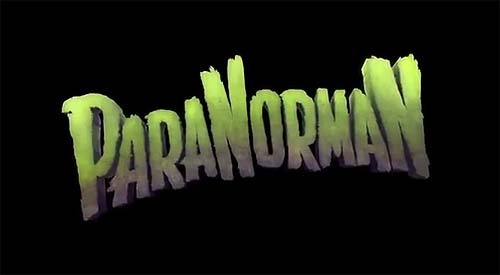
Spoilers below.
Have I seen it before: Yes
Did I like it then: Yes.
Do I remember it: Yes.
Did I see it in theaters: Yes.
Was it a movie I saw since August 22nd, 2009: Yes. #176.
Format: Blu-ray
1) It is with this film that Laika proves they were more than just a one hit wonder, that they could make a great film more than just once with Coraline. I’m glad they did, because now we’ve got four great films from the studio.
2) Whereas Coraline was Stephen King-esque in being atmospheric and creepy (almost German Expressionist), ParaNorman establishes that this is a different kind of macabre film. More the fun horror that marked the zombie movies of the 70s than the atmospheric haunts of Coraline. That is not to knock the film or even say it is better than Coraline, but instead to observe that they are different. This is mostly clearly established by the film within the film which opens ParaNorman, definitely made in the style of those old crummy 70s horror films.
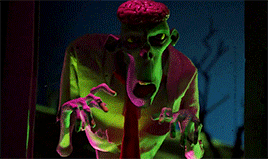
3) Norman.
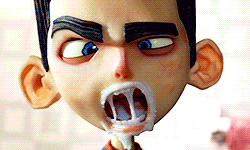
Just like with Coraline, Laika is able to craft a child protagonist who is - above all else - an honest representation of what is’ like to be an eleven year old kid. Norman doesn’t make any effort to hide the fact that he sees dead people and he faces ridicule for that everyday. Except he’s eleven! Eleven year olds are taught to not lie to adults, so why would Norman lie?
But more than that, Norman is a great representation of the “weird” kid. The kid who likes horror and old monster movies, the kid who exists EVERYWHERE in the world but doesn’t often see themselves represented in media (something which feeds their status as “weird”). Like most of these kids, Norman is largely kind but tries to keep to himself. It’s easier that way. Less people to make him feel like a freak. He knows how hard it is that no one listens to him, which makes his superpower being able to communicate to those who are often not heard (aka: dead people). But more on that later.
Norman is just a wonderful character and Kodi Smit-Mcphee does an excellent job as Norman’s voice actor. Like the writing, he is able to portray Norman honestly. No Breakfast Club-y “oh woe is me” stuff, just a quiet frustration from not being listened, from being written off as a freak time and time again. Smit-Mcphee is great in the part and I think Norman is better off by having the actor’s voice.
4) Norman’s family life is INCREDIBLY frustrating to me, but that’s the entire point. Both his dad and his sister are kinda jerks just because Norman’s weird. What’s so wrong with being a little weird? As long as you’re not hurting people. But again, it is a source of great conflict for the film.
5) Norman’s walk through town is uniquely imaginative, showing these ghosts not in a frightening but instead a fun and unique way. They each have their own character we understand in just a few seconds after meeting them. A great way to introduce us to his world.

6) Alvin just makes me…sad.
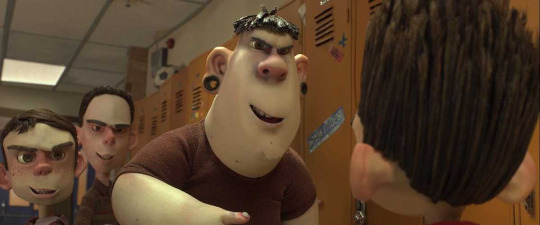
The total loser asshole who thinks he’s hot shit when really he’s just a moronic bully with an inflated ego of himself. The very existence of bullies like this makes me feel sad about their existence. (I don’t like bullies, can you tell?). Also how much of a tough guy are you if you’re named Alvin? Not to diss anyone with the name Alvin, but it’s not your typical bully name. That may just be the point though, as Christopher Mintz-Plasse (best known as McLovin in Superbad) is not your typically bully voice. In most of his early films, he was the character getting bullied.

7) I always appreciate creative ways of introducing necessary backstory to a film. This movie using the crummy school play to explain the Blithe Hollow witch and her curse is a nice, seamless, and entertaining way of letting us know information which is going to become VERY relevant later on.
8) Ah, Neil.
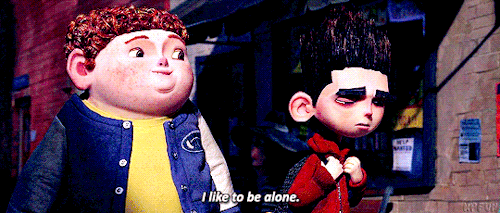

(GIF originally posted by @kpfun)
Neil is great. Another honest representation of a kid. In this case a kid who isn’t really bothered but the jerks. He knows who he is, he’s fine with who he is, and he’s not going to let anyone feel bad about it. He’s also IMMEDIATELY nice to Norman and throughout the film he is consistently loyal to him, always listening to what his friend is saying. He also just accepts the fact that Norman can see ghosts, without question and without judgment. I really like Neil. I think we all need to be a bit more like Neil.
9) Uncle Prenderghast.

John Goodman has a brief but memorable role as Norman’s Uncle Prenderghast, who can also see ghosts. HE is able to play Prenderghast’s sense of crazy quite well, coming off as wonderfully unkempt AND giving us our best earliest flavor for the film’s sense of humor.
[Uncle Prenderghast dies, his spirit starts to leave his body, then the spirit comes back to his body and he sits up.]
Uncle Prenderghast [laughing with glee]: “No! Not yet! Not ye-”
[Uncle Prederghast dies and becomes a ghost.]
Uncle Prenderghast: “Oh nuts.”
10) THIS. FREAKING. SCENE.
Norman [after causing a scene at the school]: “I didn’t ask to be born this way.”
Perry [Norman’s Dad]: “Funny. Neither did we.”
Sandra [Norman’s Mom, to Norman]: “You know, sometimes people say things that seem mean but they do it because they’re afraid.”
Norman: “He’s my dad. He’s not supposed to be afraid of me.”
Sandra: “He’s not afraid of you. He’s afraid FOR you.”
I have so many emotions here. After Perry’s snide comment I’m truly angry, but then when Norman makes the observation about fear I get sad and then after Sandra’s line about why Perry is afraid I stay sad but like a different kind of sad if that makes sense. It’s just, I love everything about that exchange.
11) I will say, this film I think is funnier than Coraline.
Uncle Prenderghast’s Ghost [asking Norman to keep the witch’s curse at bay]: “SWEAR!”
Norman [after hesitation]: “You mean…like the f-word?”
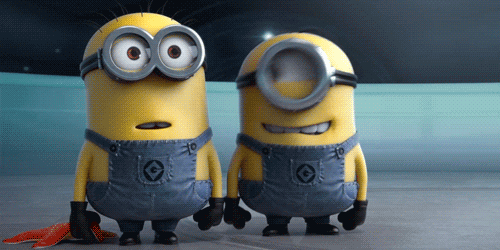
12) This film gives us two great meta jokes back to back.
[Norman’s phone rings and it’s the Halloween theme]
Text Message: “Come to the window.”
[Norman goes to the window and jumps at what he sees.]

Neil: “You wanna play some hockey?”
It knows the genre it’s playing in and does it wonderfully.
13) This line sort of breaks my heart.
Norman [after telling Neil about the witch’s curse]: “Go home Neil. I’m better off on my own anyway.”
Norman is used to people not listening to him and holding him back because of it. He really doesn’t feel like he has anyone to count on, so he’s not used to Neil’s support and instinctively sends him away. That’s a really lonely life.
14) There are certain quotes in films we should all try to live our lives by. This is one of them:
Grandma: “There’s nothing wrong with being scared, Norman. So long as you don’t let it change who you are.”
The brief moments we see between Norman and his grandma provide a nice, interesting relationship. I sort of wish there were more of them but I also appreciate how the film flows as is, so I’m glad we got the peek we did.
15) This film does a good job at being scary when it wants to be. The scene when Norman is snooping around his dead uncle’s home looking for the book he was told about actually had me jumping a little bit. I love that.
16) I just want to take a minute to appreciate how this scene is visually.
youtube
The horror fantasy of this world just erupted in a no-holds-bar way and that is made very clear to us as the audience in an effective way.
17) I love Anna Kendrick in anything, even if it’s just her voice.
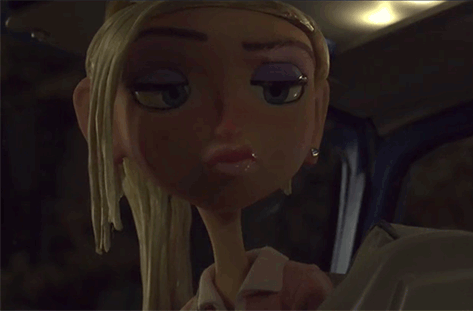
Norman’s sister Courtney is a wonderful kind of awful. She’s the bratty older sister who doesn’t really care about her brother at the start, he’s just an embarrassment. But as the film goes on you can see that the two are siblings and that they will stand by each other. But while Courtney is being more antagonistic we are given some strong comedy and character and Kendrick’s voice just works wonderfully in the part.
18) Neil’s brother, Mitch.
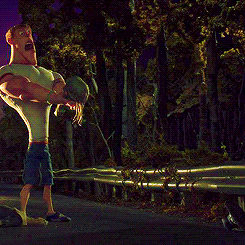
Mitch is a really fun character. He’s sort of your atypical dumb jock type but we get to see more of that. We get to see how he’s not the worst older brother, how he’s less of an outright jerk to Norman and more just an insensitive dunce, and he has some of the best comedy moments in the film. Mitch’s voice actor, Casey Affleck (who I will only be discussing in the context of this film, not the controversy which surrounds him because this really isn’t the best place for me to talk about that) uses his wispier voice to add a juxtaposition between Mitch’s body and his mind, being able to convey his warmth/humor/thickness in a unique and entertaining way.
19) Once the entire ensemble comes together, there is some wonderful comedy.
Alvin [after the zombies trap him and Norman]: “Are they going to eat our brains?”
Norman: “I think you’ll be safe.”
Just a heads up: out of the next seven notes, about six of them deal with how strong the comedy in this film is. You have been warned.
20) The zombies trapping Norman and Alvin in dead Uncle Prenderghast’s house actually creates some nice scary moments, while still keeping the humor and heart this film has established so far. Working well in the genre it has established to create tension and stakes while also providing us with some good laughs.
21) There is some really strong slapstick comedy with the zombies in this film, let me just say.



(GIFs originally posted by @the-light-of-animation)
22) I told you the next few notes are me going to be commenting on how strong the comedy in this film is.
Courtney [to/about Norman]: “I just knew something like this was gonna happen tonight?”
Mitch [sincerely]: “You did? Wow! Because that zombie bit really threw me.”
23) This is quite possibly my favorite joke in the whole film.
Neil [to Mitch]: “You’re the oldest.”
Mitch: “Not mentally!”
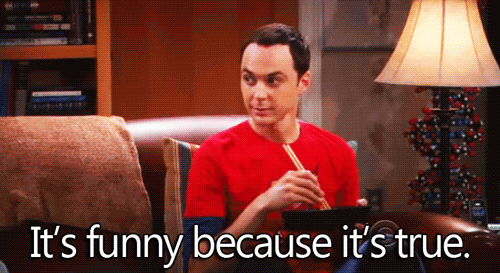
24) Okay, I swear the next note after this will be more than just a comment on how funny something in this film is. But come on, the vending machine scene…
youtube
25) The message of this film ends up being incredibly surprising and compelling. The fact that the zombies are NOT the monsters in this situation, but the people just start attacking the zombies because they’re different. That the people are the ones who’s arms break through the walls of city hall like it’s Night of the Living Dead. That the living human beings who act based on fear and bias are more dangerous than the living dead. I think that’s a really strong message that the film works quite well with, elevating it above just your standard genre film.
26) Okay, this is the last note on a joke for a while I swear. But, come on…
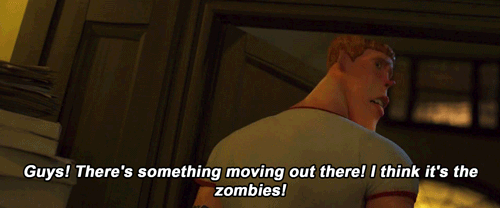
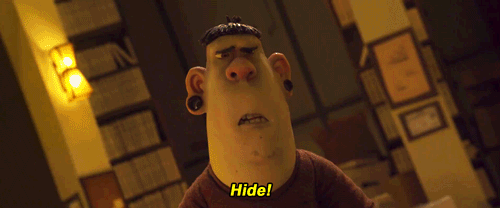

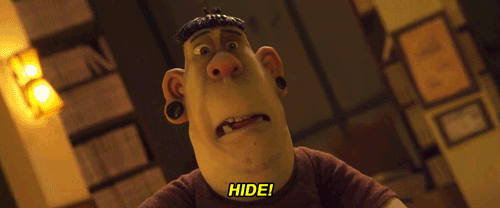
(GIFs originally posted by @the-light-of-animation)
27) This is one of a few scenes which breaks my heart:
Courtney: “I’m scared Norman and I can’t listen to this anymore.”
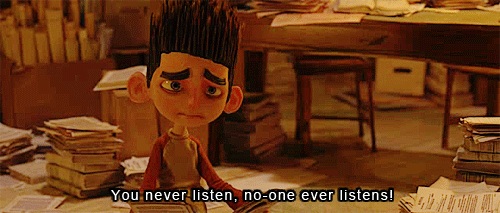
(GIF source unknown [if this is your GIF please let me know].)
The most frustrating part of the existence of the average kid is that no one listens to them. That they are written off or talked down to even when they’re right and/or dealing with some massive situation. “They’re just a kid,” is a common phrase to diminish the actions or feelings of a child. And that SUCKS. It sucks being consistently not being heard, being consistently written off. The reason so many kids feel like no one understands them is because so few people TRY to understand kids. We forget how hard it was being a kid because why would we want to remember that pain? That frustration? Being an adult is hard enough, it’s easier to think that being a kid was easy. But it’s not. And kids everywhere constantly wonder what they’re doing wrong that their life isn’t as easy as how adults remember being a child is. And it just sucks.
28) Honestly, this is the scariest part of the movie for me:
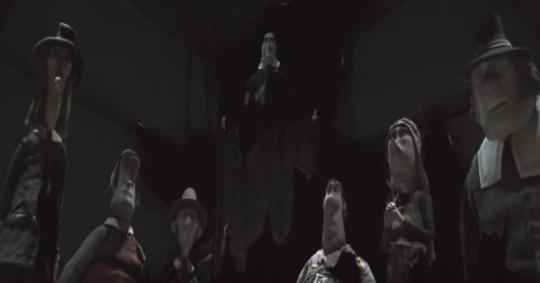
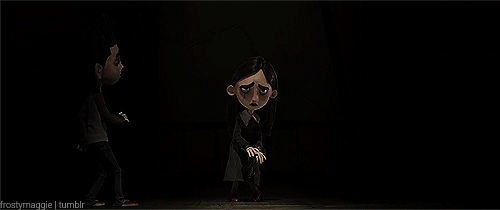
(GIF originally posted by @maggins)
The big bad witch, the one the entire town’s tourist industry is based on, the one who’s death has become pop culture for them inspiring casinos and school plays celebrating her death, that witch…was a seven year old girl who was executed because she was different. Because adults were afraid of her and acted badly out of it. And the scariest thing is: it’s not that far from the truth. Look at Salem. Look at somethings today. People hurting innocents just because they don’t understand them. Just because they’re different. History is marked by putting people - including children - to death because they were misunderstood. The scariest part, the most heartbreaking part, about the reveal that the witch is a seven year old girl is that it’s the least fictional part of this movie.
29) For how much of an awful sister Courtney can be in the first half of the film, remember this: she stands with Norman fist. It’s her brother standing in front of an angry mob defending a bunch of zombies and she doesn’t even really hesitate (only enough to process what’s going on) before she stands with her brother and shouts the adults down before anyone else. Before Neil, before Mitch, before Alvin. Courtney is there for her little brother. And because of her everyone else follows suit.

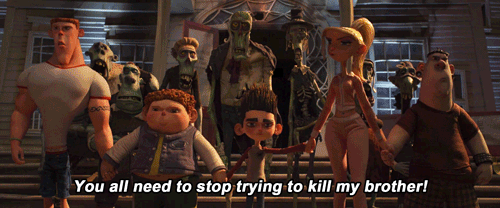
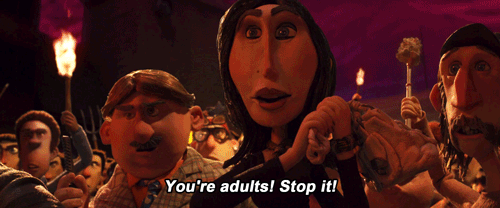
(GIFs originally posted by @the-light-of-animation)
And then she encourages Norman! She helps him! Albeit with a very Courtney speech, but still she supports him!
Courtney: “I have cheered the uncheerable Norman. I’m not letting you give up now.”
30) Okay, so I’m not done commenting on how funny some of the jokes are in this film.
[Norman, Courtney, and the zombie are in the backseat of their parents car]
Courtney: "Ugh, Norman! He’s on my side of the seat.”
Norman: “She wants you to move over.”
[Zombie groans at Courtney.]
Courtney: “Um, I heard that! Mom, stop the zombie to stop saying stuff about me!”
Norman: “Will you quite using the z-word?”
Courtney [mocking]: “Will you quite using the z-word?”
Perry: “So help me I will stop this car right now if all three of you don’t quite it this instant!”
31) Okay, the entire Norman/Agatha climactic scene.
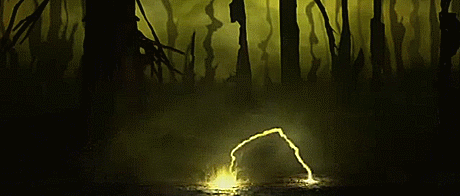
(GIF originally posted by @ikejamese)
This line of, “I don’t want to go to sleep and you can’t make me,” as a whisper in Norman’s ear in nothing but silence is a great way of establishing how straight up scary Agatha can be.
I love this electric design of Agatha.
Agatha has always been stopped in the past by someone reading a bedtime story to here, and Norman KNOWS this isn’t changing anything it’s just delaying it. So he uses the format of a bedtime story “Once upon a time…” to relate to Agatha and what she’s been going through in a way which frightens her. Because that’s something she’s buried away. She doesn’t want to be afraid, she wants other people to fear her. And it really shows how Norman’s superpower is communicating because he is able to do what no one else has: he is able to actually talk to Agatha.
The visuals for this scene are just incredible. Not only with Agatha, but with the void and the fighting and…gah! It’s delightful eye candy.
And then when Agatha goes back to being Agatha, this scare little girl who was hurt worse than any seven year old ever should, my heart breaks.

(GIF originally posted by @laikaworld)
And in the continuing trend of this scene breaking my heart:
Aggie: “I just want my mommy.”

(GIF originally posted by @marshmallow-the-vampire-slayer)
32) I think it’s really powerful that, once the curse is lifted and the zombies just go back to being ghosts, they don’t smile. They’re not at peace. They still have to exist with that guilt and the fact they murdered an innocent girl because she was different than them. They don’t deserve a smile. I love that.
33) THIS! FREAKING! SCENE!!!!!!


(GIF source unknown [if this is your GIF please let me know].)
I believe Mitch is the first openly gay character in a mainstream animated film. In an interview with EUR Web, co-director Chris Bulter said:
It was part of the tolerance thing. It seemed important that we be brave about it. If we’re saying to anyone that watches this movie don’t judge other people, then we’ve got to have the strength of our convictions.
I love that.
34) With this film, Laika starts a tradition of including a fun “behind the scenes” post-credits clip showing how they make some of their film. It shows just how much they care about their work and I love that we got similar bits in The Boxtrolls and Kubo and the Two Strings. It’s basically the featurette below, just watch from nine seconds to a minute and nine seconds.
youtube
ParaNorman is a great film. It has an incredibly strong message of tolerance and making sure you don’t let your fear change you, the animation is exquisite, there is just so much humor and heart, there are some truly wonderfully frightening moments, the voice acting is incredible, and it is just an amazing ride through and through. Go see it if you haven’t watched it yet. Seriously.
#ParaNorman#Source: Paranorman#Laika#Kodi Smit McPhee#Anna Kendrick#Epic Movie (Re)Watch#Casey Affleck#Christopher Mintz Plasse#John Goodman
10 notes
·
View notes
Photo

Enzo Smits
On subculture, memories and the art of doing nothing.
Dutch translation.
Date of interview: march 2018
Estimated reading time: 12 minutes
Truth be told, Enzo Smits (1988°) is no stranger to us. We met him about ten years ago in the local skate scene of Mol and to this day we still share the same world of interests. Today we meet Enzo on a fairly sunny Sunday morning at the South Station of Brussels. This time not for skating, but to discuss his work as a filmmaker and screenwriter.
Enzo grew up in Mol, but has been living in Brussels for about ten years now. His developing body of work includes the short films ‘All We Ever Wanted Was Everything’ (2014) and ‘It won’t be long now’ (2016), the group exhibition ‘Nothing is Cool’ (2015) and the scenario for the comic ‘Wolves’ (2016). As owner of book and record shop ZWART-WIT, Enzo displays his daily life as an idiosyncratic selection of reading and listening material. Somewhere between all these things, he finds the time to work together with illustrator Ward Zwart on a second comic.
Before heading to his apartment, we start the day off with a msemmen, a delicacy of Maghreb origin that strikes a balance between bread and pancakes. Feta and olives? Yes please. After a short walk through Saint-Gilles we arrive at his apartment in Vorst. We’re served a black tea as we reminisce over past memories. After thriving in his natural environment for a while, we move the conversation to Le Petit Molière, a cosy café just down the street. That’s when the conversation really gets going. To the soundtrack of "I Can’t Live Without You", "Roxanne" and "Staying Alive" the locals make themselves at home.

Skateboarding is, albeit indirectly, a theme that often recurs in your work. You were a skater yourself during your teenage years. How do you look back on this period?
Skateboarding is super interesting, but the skating itself wasn’t my strongest feature. Pretty soon I felt that I wasn’t going to be very good at it and I started to focus more on filming and shooting photos of my friends.
That's how I discovered the 'creative side' of skateboarding whilst being introduced to a whole bunch of new things. A brand new world opened up to me in terms of music. But I also got to know filmmakers like Mike Mills, Spike Jonze and Harmony Korine this way. I think that, as is the case with every teenager, subculture is a good way to discover other things. In that regard, skating was just a starting point for me.
It’s also true that skating, and in particular hanging around and searching for places, has unconsciously had a strong influence on how I make films now. As a skateboarder you learn to look at a public space in a different way. I think that’s how I developed my fascination for parking lots and other non-places. Places that actually have a very specific purpose, but are used by skaters in a whole different way.
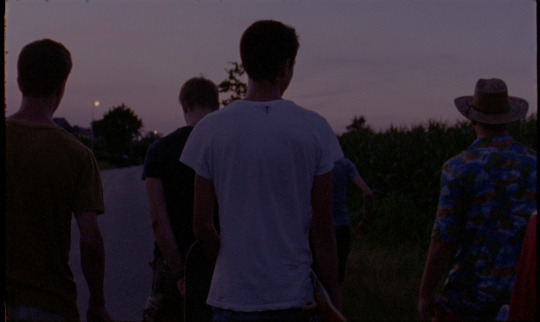
16mm-still from All We Ever Wanted Was Everything (2014)
In your graduation project ‘All We Ever Wanted Was Everything’ (2014) we follow a group of young skaters. How did the creative process of this film come about?
It took a long time before I knew how I wanted to make that film. I didn’t want it to be just another story about skating. I have yet to see a story in which everything revolves around the act of skateboarding itself, to be filmed in a successful way.
Instead I wanted to show everything that happens in the margin: the moving around from spot to spot, the waiting and all the non-moments that stuck with me. That’s also the reason why I wanted to make a film, with people I knew at locations I was familiar with. I did have some idea beforehand of how I wanted it to look like, but there was no fixed script. It would’ve been weird to force text on people. For me it was just as valuable if someone said: "My toes are numb", than any text I could have written. Why would I impose my vision purely upon these people instead of letting them tell the story themselves.
Throughout the making of the film we gradually discovered how we wanted to tackle this subject. The idea was that the film would have the structure of a photo album. That you as a viewer could let your eyes glide from image to image and that the story gradually unfolds. That’s the main idea, but then you still have to convert that idea into a process. At times the filming itself looked very much like hanging around and skating, but with a clear goal in mind. Our 'scenario' became more of a map consisting of places, people and situations. During productio these elements were then brought together and we gradually came to the final result.
The movie was shot on actual film. Why is that?
In terms of material we deliberately opted for a minimal setup: one camera, two different lenses, two types of film and no added light. As a result, we often had to wait for the right light or accept that certain things weren’t visible. Turning on a pellicule gives a grainy character to the image. It was clear beforehand that we would mainly film still images: empty rooms, still lifes, environments, ... Because of the grain you feel as a viewer that there is movement, that you are not looking at a picture or a frame.
Apart from the aesthetic aspect, using 16mm film also entailed a certain method. Unless you work with huge budgets, which is certainly not the case with me, you have to choose much more carefully what you shoot or don’t shoot. In addition, you can’t immediately review the shots. Because of this, during the editing process I had already forgotten certain considerations that I had at the time of filming. I could see the images as just … images. But that certainly doesn’t mean I reject the digital. Each film requires a certain working method. For me the question "How do I make this film" is just as important as "What kind of story do I want to tell". It differs from project to project. For example,'It won’t be long now' (2016), the short film that I made for the 4x7 series for Canvas (broadcasting station), was fully digitized. Apart from the neighborhood views in the beginning, which were made the day before, everything was filmed in one evening. The film is made up of only a handful of long shots, so that the course of time becomes tangible. The best moments in the film came about when it was unclear whether the camera was running or not. Since my characters had never been in front of a camera, this was a convenient way of working.
For me it was just as valuable if someone said: "My toes are numb", than any text I could have written.

Film-still from ‘It won’t be long now’ (2016)
Young people always seem to pop up in your work. Do you cherish a certain nostalgia for your teenage years?
It’s a world that I know and recognize. It is a period that feels like one big intermediate moment, it has a certain slowness to it where you constantly seem to wait for what will come. This world lends itself very well to the stories I want to tell. What I very often tend to create is a kind of ideal, a romantic image of boredom. Boredom without it being boring. In telling something about teenagers, you can really emphasize that feeling which makes the subject so great.
In addition to this, I’m also somewhat receptive to the nostalgia and the melancholy that you can associate with it. My view of how I think about my youth is also a kind of romanticism that only comes about afterwards. I was confronted with this fact during the making of my first film. I had a certain image of the town of Mol or a similar place in my mind that did not resemble what it looked like in reality. In the end, we went searching for places like the ones in my imagination. I’ve been deliberately engaged in maintaining these memories and trying to show a realistic picture of it.
What I very often tend to create is a kind of ideal, a romantic image of boredom. Boredom without it being boring.

The images in your films tend to be quite static. Is that primarily a contentual choice?
I quite often make the choice to film on a tripod. But that might also have something to do with my fascination for photography. I like it when time becomes something tangible/palpable. When this happens, the viewer is given the space to recognize himself in a certain moment or situation. A space between images arises, in which you can create your own stories as a viewer.
I also find this true for books. Even if it’s just about turning pages. One of the few remarks I might give on Ward's drawings is: "Make it longer or try to stretch that action a bit longer."
Do you always choose to work with a small production team?
By working on other films I discovered that the machinery behind a movie is not really my thing. This was my reason for working with a small teams ever since. I want to work with people I trust instead of a big team that only slows everything down on set. If you’re working with forty people, you can no longer jump into the car at the last minute to film somewhere else. Sometimes I'm jealous of photographers because they only have to take care of themselves. Yet I would miss the dialogue with other people. I think I’m looking for the best of both worlds. With Grimm Vandekerckhove as DOP and Kwinten Van Laethem as sound engineer I found 2 people that I feel think about film in the same way I do. So for the time being I do not see why I should need more people.
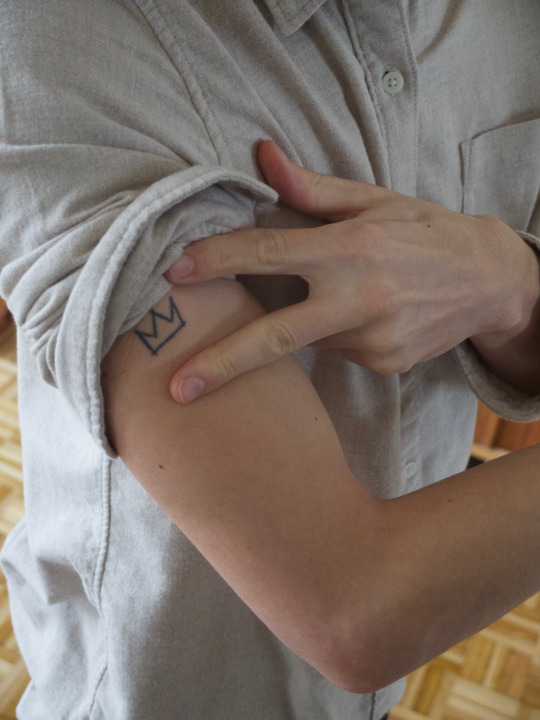

How can the exhibition ‘Nothing is Cool’ be situated within the context of your work?
‘Nothing is Cool’ is a something I already spoke about with Nick Geboers and Stef Renard while filming for ‘A.W.E.W.W.E.’ The way a film is shown has an enormous impact on it’s reception. Too often films are arranged within a program of other shortfilms with whom, apart from the length, they have nothing in common. Yet these films affect each other and people unconsciously compare or link them.
Nick and Stef both work regularly on youth and skateboard culture, it seemed interesting to work with them and build a groupshow on this theme where different media could be combined. Sarah Hermans also joined the show quite quickly. Everyone approached the theme in his or her own way. While building the show everything seemed to fall into place.
I showed ‘A.W.E.W.W.E.’ in loop on a tube television. It happened that people started watching in the middle of the film. Up until now this was for me the most satisfying showing of the film. I also had the feeling that people suddenly understood it better by placing it within the bigger picture.
By limiting yourself in terms of scenario and the way of filming, you try to determine as little as possible in advance. Isn’t this a big difference with the narrative structure of ‘Wolven’ (2016), the comic in collaboration with Ward Zwart of which you wrote the scenario?
The stories in ‘Wolven’ are in that comic and not in a film because the stories have more in common with the structure of narrative fiction, for instance the use of dialogues. A lot of the stories in Wolven are unfinished scenario’s for shortfilms. The format of a comic permits me to get rid of these stories someplace else. But you can also add unrealistic elements in a comic and thus respond to the emotional world of the characters better. Finally, an animated dialogue is less decisive than one that is spoken out.
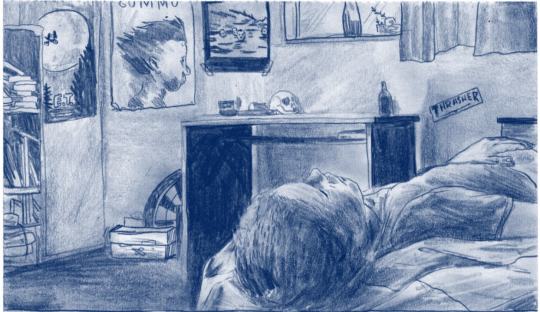
Fragment from Wolven by Ward zwart
A lot of the stories in Wolven are unfinished scenario’s for shortfilms. The format of a comic permits me to get rid of these stories someplace else.
Do you have a regular routine while writing?
I admire people who can sit at their computer in the morning to start working right away. It’s really quite the opposite for me. For the greatest part, my work process consists of doing nothing, or at that moment thinking that I am not doing anything but being busy in a unconscious way. I walk around or gaze in books, I waste a lot of time behind the computer or I listen to music and suddenly there is one hour of concentrated work. Because I spend a lot of time commuting nowadays, that hour often takes place on the train. For me, work often takes place in between. As a result, I sometimes think of myself as being lazy or doing nothing.
When making a film it is nice that there is an effective filming period which is super intense. Then you are really busy from dusk til dawn.
Do you feel that you want to justify yourself for doing nothing?
I have already admitted that to myself, but sometimes I feel the need to justify something to the outside world. It is also difficult to explain to others what you do when you are writing or preparing a movie. One does not see how a project comes about. That is difficult to measure. I think it is a struggle for many people to accept that doing nothing is part of ones practice. I am quickly distracted, but that distraction is, at the same time, such a large part of the input. In all the things I make now, pop culture and everything related to it is super important.
For me, work often takes place in between stuff. As a result, I sometimes think of myself as being lazy or doing nothing.

It strikes me that you’re quite frank about the fact that your work is made up of the work of others. Who or what influences your practice?
In my films as well as in ‘Wolven’, I really want these influences to be part of the whole. Forty percent of my work was probably stolen in a way. A portion that I have picked up for processing. For example in ‘Wolven’ there is a character who resembles David Foster Wallace because Ward and I like him. The movie posters hanging on the wall are from films that we like. There are scenes based on a Slint song. This is no different with my films. I don’t want to just drop names however. I just believe that pop culture, subculture and youth culture are so closely related that it would be strange to ignore their existence.
People often act tough about it. But when you write an essay, you also literally state all your sources. Why would you hide everything in fiction?
Forty percent of my work was probably stolen in a way. A portion that I have picked up for processing.

"Small town growing up" is a recurring theme in your work. You have been living in Brussels for a while now. Can we expect a story taking place in our capital soon?
Apart from school assignments I have never filmed anything in Brussels. I would love to do that, but there is still a feeling that it is not up to me to tell anything about the city. Many films about Brussels create a certain image of the place. You thereby create a stigma. While I do the same for Mol. I also give an unrealistic picture, but at the same time that has much more to do with an emotional world. I only discovered that and dared to admit it by making work about it. At first I wanted to resist, but I always returned to Mol to make films. For the new book, for the first time I started making something that took place in a city. But in the first scene the main character takes back the train to some allotment.
We end the conversation with "Another brick in the wall" in the background. The regulars open their throats and make their first modest dance moves. Enzo is not really in the mood for dancing, we decide to hang around in Brussels and let the day slumber on.
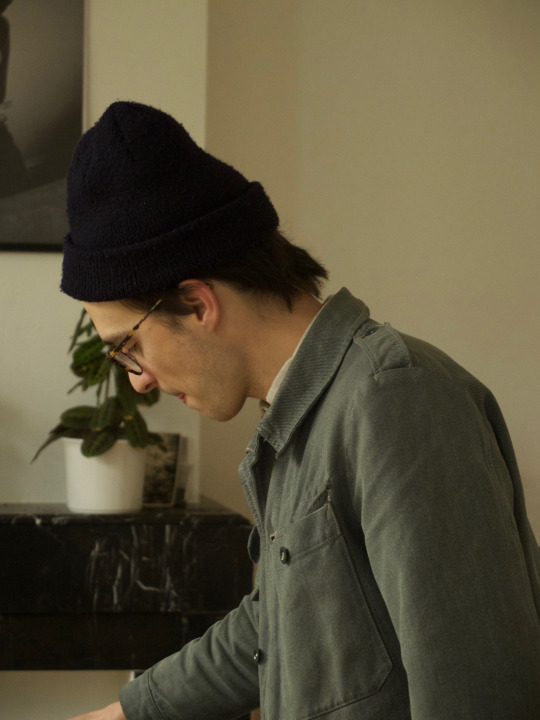
Blog A.W.E.W.W.E. It won’t be long now Wolven
Interview : Alexander Delport, Jakob Van den Broucke Translation: Alexander Delport, Jakob Van den Broucke Photography: Alexander Delport, Jakob Van den Broucke, Enzo Smits English editing: Tessa Vannieuwenhuyze, Maxim Ryckaerts
_
0 notes
Text
My List of Favorite Horror Films
(Also reasons why I like them. Why? Because I’m FUCKING BORED AF)
1408 (2007)
- Okay, the reason I like this movie so much is a bit ridiculous-sounding. You know when you find a certain horror movie that just completely scares you and you can’t get it off your mind? Well, that’s what a certain movie did to me. I couldn’t get that movie out of my mind, so I decided to watch this to help. And I ended up thoroughly enjoying it. Good casting, good plot, good jump scares. A real head-trip of a film.
The Shining (1980)
- This one is pretty special because it’s the first horror film I watched unblocked (meaning not on Syfy channel or AMC where it’s censored). I didn’t find it extremely scary, just very unsettling. I mean, think about it. A family moving into a haunted hotel during the winter, the father descending into madness caused by a mix of cabin fever and ghost manipulation. If you’re used to outright scares, this would be child’s play for you. Creepy music, great script, awesome head-trips. Right up there with 1408.
Misery (1990)
- This is also high on the list due to the fact that it helped me learn how to type fast (I only use my middle fingers; Paul Sheldon only uses his index fingers). This film brings the term “fangirl” to a whole other level. You think Beliebers are crazy? You clearly haven’t met Annie Wilkes. Expert casting (Kathy Bates, James Caan, Lauren Bacall, etc.), unsettling forms of torture, and a good use of music from the one and only Liberace. Plus, some fun scenes to act out when I have nothing else to do.
Let the Right One In (2008)
- The main reason I love this film so much is because it’s a vampire love story done RIGHT. A Swedish film based on the novel of the same name, it follows a bullied boy as he befriends his vampire neighbor. Their friendship eventually blossoms into a romance (which is platonic, for the most part; something else I loved). Despite their cute relationship, it also has a good amount of gore and frightening scenes, something I love in horror films.
Let Me In (2010)
- This is basically the same as Let the Right One In, due to it being an American remake of the latter. Fortunately, unlike most American remakes, this is actually quite faithful to the source material while also adding in some new aspects that work with the setting. The cute relationship between the boy and the vampire, the gore and frightening scenes. Also great casting with actors such as Chloe Grace Moretz, Kodi Smit-McPhee, and Richard Jenkins.
Saw (2004)
- Words can hardly express the love I have for this movie. Why do I love it so much? Think. What’s a main thing that happens in several horror films of the 21st century? Sex, sex, sex. Why I love this film so much is because it doesn’t have any subplots of sex scenes or sensual nudity (the burn victim doesn’t count in this scenario). It only focuses on the scare and gore factors. Not to mention a great plot twist at the end that could be seen as a metaphor for real-life.
House of 1000 Corpses (2003)
- This goes along with the same feeling as Saw. Although there are several scenes of graphic female nudity (only breasts), this film also doesn’t focus on sex. Gritty, violent, and over-the-top, this film is one of my favorites in the gore genre. The music fits well with the film’s theme (thank you, Rob Zombie), and the Firefly family is made up of violently-wacky characters, ranging from the sadistic Otis to the childishly-violent Baby to the foul-mouthed and psychopathic Captain Spaulding. Definitely worth watching if you don’t have a weak stomach.
Pet Sematary (1989)
- Another of my favorite Stephen King films. This film definitely exceeded my expectations. From the pet cemetery behind the Creeds’ home to the baby coming back as a murderous shadow of his former self. However, if there was one thing I didn’t like about this film, it would be my abhor toward Ellie Creed, Louis’ young daughter. Aside from her, the film had great jump scares, a fair amount of gore, some memorable quotes, good casting with actors such as Dale Midkiff, Denise Crosby, and Fred Gwynn, and (again) NO SEX!
Creepshow (1982)
- This comedy-horror is an absolute delight to watch. Directed by George A. Romero and written by Stephen King, this horror anthology film is great for those who like horror comics. A slew of great actors (some favorites are Ted Danson, Ed Harris, Leslie Nielsen, Hal Holbrook, and Adrienne Barbeau), great special effects makeup, and a mix of laughs and scares. What more could you ask for?
The Mist (2007)
- Who doesn’t love a good monster movie? Based on the Stephen King novella and brought to the silver screen by Frank Darabont, it follows several people recovering from a hurricane, now trapped in a supermarket as a thick mist (which houses giant, man-eating monsters) settles over the town. But what makes this film great is the main focus being on the peoples’ descent into madness, brought forward by the preachings from religious zealot, Mrs. Carmody (played expertly by Marcia Gay Harden). Violence, human sacrifice, and a shocking and traumatic ending. This is a film you wouldn’t want to miss.
IT (1990 and 2017)
- Everyone loves clowns, right? Based on one of Stephen King’s longest novels, both the miniseries and the new film follow a group of children trying to face and defeat a shape-shifting child-murdering monster, which mostly takes the form of a clown. Everyone knows Tim Curry’s legendary portrayal as Pennywise the Dancing Clown, but Bill Skarsgård manages to create an almost-equally terrifying monster. Violence, great scares, and great castings in both. Though obviously not a film for everyone, anyone who can handle creepy clowns should see this.
Mama (2013)
- Sure, this film may have been seen as a bit overrated, but I thought this film was absolute genius. An illustrator and his musician girlfriend take in his nieces, who have been missing and reduced to a feral state after years of isolation from civilization. However, something has come with them and is intent on keeping the girls for herself. Having a few unintentional similarities to Corpse Bride (I talked with the director about it), and expert casting with actors such as Jessica Chastain and Javier Botet, this film has a great storyline, decent jump scares, and an ending that punches you in the gut with shock.
The Conjuring (2013)
- True stories help mold the best horror films. Based on one of real life paranormal investigators Ed and Lorraine Warren’s most memorable cases, this film follows the Perron family as they experience horrifying paranormal phenomena in their new farmhouse. Great scares, awesome casting (Patrick Wilson, Vera Farmiga, and Lili Taylor), and awesome storyline. What would you expect from James Wan (aka, the director of Saw)?
The Conjuring 2 (2016)
- A sequel to The Conjuring, and a damn good one to boot. Based on another of Ed and Lorraine Warren’s cases, this follows the Enfield Poltergeist where two sisters in Brimsdown, Enfield, England encountered a violent spirit that would speak through the younger one and would throw them (as well as other objects in the house) around. Adding a subplot of Lorraine’s faith being challenged by a demon disguised as a nun, the film, like its predecessor, has great jump scares and expert casting. I should also mention that I watched this while that movie was in my head again.
Annabelle (2014)
- Anyone who’s scared of those antique dolls should steer clear of this one. While the storyline is entirely fictional, the doll (Annabelle) is quite real. Based on a real life Raggedy Ann doll, this prequel of The Conjuring gives us an idea of how the doll came to be a conduit in the first place. Several moments of worry for the characters and jump scares including both the doll and the demon using it, the film makes your stomach turn once the doll makes its first appearance.
Annabelle: Creation (2017)
- A prequel of said prequel, this films shows the doll’s origins. After the death of their young daughter, a dollmaker and his wife begin to see her spirit and give her permission to use the doll. Bittersweet, right? Wrong, because this “spirit” isn’t their daughter. After they turn their house into an orphanage, one of the little girls becomes a person of interest to the demon. Though some may laugh at the girls’ stupidity (as most white people in horror films are), the films boasts great jump scares and a surprise twist ending.
The Boy (2016)
- Though not as popular as a lot of the other films I’ve listed, I fully love this film. Why? Well, this is the first horror film I’ve ever watched in theaters (Annabelle: Creation and IT were second and third). With actors like The Walking Dead’s Lauren Cohan and Hellboy’s Rupert Evans, the film follows an American woman taking the job as a nanny for a rich British family, only to find that the child she’s watching is a doll. Some good jump scares, creepy setting, and a plot twist that no one would’ve ever expected, this is definitely listed as one of my favorites.
(TO BE CONTINUED AT A LATER DATE. ENJOY ME SOUNDING LIKE A FUCKING MOVIE CRITIC)
1 note
·
View note
Text
Dawn of the Planet of the Apes (2014)
Rating: 8.9/10
Dawn of the Planet of the Apes is a 2014 sci-fi action film directed by Matt Reeves. It stars Andy Serkis, Jason Clarke, Gary Oldman, Toby Kebbel, Keri Russel and Kodi Smit-McPhee, along with Kirk Acevedo, Nick Thurston, Terry Notary, Karin Konoval, Judy Greer, Jon Eyez, Enrique Murciano, and Doc Shaw. The film is a continuation of the Planet of the Apes reboot franchise, and begins 10 years after Rise of the Planet of the Apes ends. After the fall of humanity due to the Simian Flu, the augmented apes have formed a new society in the woods outside San Francisco under Caesar’s leadership. The apes come into conflict with a group of humans from a compound nearby, searching for alternate power sources, and tensions begin to rise between the two species, as well as within the apes’ own ranks.
The sequel to Rise of the Planet of the Apes outshines its predecessor in its visuals. Improvement is immediately noticeable. Andy Serkis once again provides a stellar motion capture performance, yet at this point it is almost expected. Another motion capture ape actor whose shines in this film is Toby Kebbel as Koba. Once again, the eyes say it all in this film. Both of these actors, as well as Nick Thurston and the other ape actors, give excellent nuanced performances. Speaking of nuanced performances, Gary Oldman as Dreyfus, the leader of the San Francisco survivors, transforms what could have become a usual one-note post apocalypse villain into a remarkable anti-hero.
One of the places the movie tends to falter is in its characterization. This film is very hit-or-miss when it comes to fleshing out its characters. Some, like Caesar, Koba, and Dreyfus are well-rounded and fully-realized, yet others, like Rocket, Carver, and others seem like wasted potential for good characters. However, the movie makes up for this by doubling-down on my favorite part of the first movie - all-out ape-action. Once again, the action scenes are by far the best part about this film, in particular the big battle scene in the second act.
Aesthetically, Dawn of the Planet of the Apes is much darker than its precursor. I hate to be cliche and compare this sequel to The Empire Strikes Back, but that’s the best way to describe it. It’s darker, has a more developed story, and ends on an ominous note - which is a welcome shift in tone, to be honest. The apes’ war paint as well as the “scarecrows” Malcolm encounters in the woods and other frightening imagery and scenes hammers home to the viewer the reality of the situation - that hyper-intelligent apes would be terrifying to behold.
Dawn of the Planet of the Apes is definitely as good if not better than Rise of the Planet of the Apes, bringing updated visuals with enhanced action and drama, though there are some persistent problems with focus of characterization. In spite of this, fans of the first movie should be encouraged to see its sequel, as it continues to provide everything the first Planet of the Apes reboot had good going for it, with improvement in many different areas. It recaptures many of the beats present in Rise of the Planet of the Apes. Those who didn’t enjoy the first film as much, or those who have never seen it, should also watch Dawn of the Planet of the Apes, as it also improves upon some of the negative aspects of the first film, providing multiple compelling characters and gripping action sequences that would make any moviegoer happy.
The apes’ acting in this movie alone makes it worth the watch, even more than the previous one, not only Andy Serkis as Caesar but also Nick Thurston as Caesar’s son, Blue Eyes, as well as Toby Kebbel’s performance as Koba, the scarred bonobo from the previous movie. Toby Kebbel shines the most during Koba’s outbursts at Caesar’s decisions (The ”Human work. Human. Work.. Human work!” scene gave me the same feeling as the “No!” scene did in the first movie). It was a bit one-note at times, but Koba had no reason to be anything other than angry at humans, so it fit nonetheless. The character of Koba is very well-written as a foil to Caesar. Both are wildly intelligent, but due to their life experiences, they use their intellect in different ways. Whereas Caesar, who was raised in a loving environment, strategizes to save the most possible lives in all situations - both human and ape - Koba uses his enhanced intillect to usurp power from Caesar and exact revenge on the humans, from whom Koba “only learned hate.” Koba is just as compelling of a villain as Caesar is as a hero, and a compelling villain is what was really missing from the previous movie.
In addition to its compelling villain, Dawn also improves upon the action scenes. In particular, the opening hunting sequence as well as the battle at the San Francisco compound are both great large-scale action sequences, but the climactic duel between Koba and Caesar is also so much fun to watch. Ape fisticuffs is something I never thought I’d enjoy watching, but the way its set up is pretty compelling - in that Caesar has to fight Koba because the apes will only follow the strong. When I first watched Dawn a few years ago, I didn’t pick up on the specific reason why Caesar had to fight Koba, but I did when I re-watched it for this review, and it made much more sense that way. There’s also a shot during the battle sequence seen from the point-of-view of a spinning tank’s cannon that is absolutely ingenious. However I still think my favorite scene in this one, as far as action goes, is the first scene, where the apes go hunting and Caesar faces down a bear. Its good, primal, cro-magnon-esque action, and I just love it. Maybe others won’t, but I certainly do.
As previously stated, Dawn of the Planet of the Apes is very hit-or-miss when it comes to characterization. Some are very well-realized, such as the previously mentioned main characters Caesar and Koba, yet others feel like wasted potential. Dreyfus made for a good human villian/anti-hero in this movie. Whereas some of the other human characters, like Malcolm (played by Jason Clarke) and Ellie (Keri Russel), fell flat, the subtlety that Oldman brought to his character made him feel like a real person and less like a generic portrait. The way Dreyfus’ backstory is revealed is much better too. Whereas we are just told the others’, Dreyfus’ tragic past is revealed to us through the scene with the iPad. It also sheds light on his motivations for future actions - why he chose to sacrifice himself to “get the job done.” He’s a soldier, what else would he have done?
While we’re talking about human villains, lets discuss Carver (played by Kirk Acevedo). Carver’s character was used to push the movie’s themes on racism, which were handled very well just like the messages were in the first movie. In the end, however, Carver is murdered by Koba, seemingly proving his point that the damn dirty apes are dangerous. Though some justice was done in this regard when Rocket (the father of Ash, who Carver shoots in the first act) saves him from the collapse in the dam, I still feel as if his character could have been given more of a chance to be proven wrong, and wrap up the racial allegories with more points on how he “never realized how similar they are to us,” or something along those lines. Some of Caesar’s lines in the third act mimic this, but coming from him (a character whose whole concept is the blurred line between human and ape, in regards to settling their differences) it doesn’t have the same effect as it would have if they had come from Carver.
The characterization of the apes is done in a much similar way. The film spent lots of time fleshing out Maurice, which I enjoyed, but it still felt as if there was so much wasted potential in the character of Rocket. Don’t get me wrong, I loved seeing Maurice as the mild-mannered orangutan who teaches the children in the village how to read as well as the hulking brute who can choke a chimp when he needs to, but I felt as if the filmmakers could’ve done more with Rocket, especially with the death of his son at the hands of Koba. Rocket could’ve foiled Maurice in that he transforms from a simple-minded bully in the first movie into a dramatic character through scenes showing him mourning the loss of his son, yet all we see about Ash’s death from anyone is a single line of dialogue from Blue Eyes. Ultimately, it was this missed opportunity for Rocket and Carver that held Dawn of the Planet of the Apes back from getting a straight 9.0/10.
Even with its mild flaws in characterization, Dawn of the Planet of the Apes is definitely one of my favorite movies so far. It adds to - as well as improves upon - its predecessors in many ways, and is once again worthy of its place as one of the best Planet of the Apes movies (if not the best) so far.
#Dawn of the Planet of the Apes#Planet of the Apes#2014 Movies#movies#sci-fi films#action films#Matt Reeves#Andy Serkis#Jason Clarke#Gary Oldman#Toby Kebbel#Keri Russel#Kodi Smit-McPhee#Kirk Acevedo#Nick Thurston#Terry Notary#Karin Konoval#Judy Greer#Jon Eyez#Enrique Murciano#Doc Shaw#entertainment
0 notes
Photo
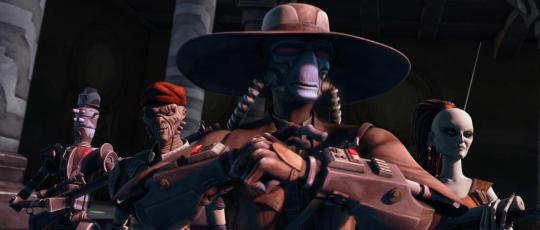
The Clone Wars: Hostage Crisis (1x22)
Summary: A bounty hunter gets the best of Anakin, holds a group of senators hostage, and ransoms the freedom of Ziro the Hutt.
Comments: And here we are: the first real episode. To pique your interest, let me start by saying I’ve sat through 21 episodes of shit just to get to this episode. I knew it was coming and I can honestly say I enjoyed myself, even the second time around.
Before I get to what will undoubtedly be a very long review, a few comments are in order.
First, this is the 22nd episode of the show, and season finale, but is the 51st episode chronologically. This only works here because Ziro the Hutt could be replaced by any character and it wouldn’t affect the plot in any noticeable way. Both the prequel and sequel to this episode appear later.
Second, the villain introduced in this episode is named “Cad Bane,” and since that’s a stupid name, you’d be correct in guessing it was George Lucas who named him.
Third, when I’ve told others about the first two seasons of this show, I have mentioned there’s really only two episodes that stood out to me that I remembered. This was the first. (The second is in Season 2 and, stupidly, gets very low reviews—stay tuned!)
Okay, let’s begin.
This episode begins with Cad Bane (a mercenary) and his team infiltrating the Senate building on Coruscant. My only problem with Cad occurs here because—rather than out-thinking the Senate guards as in all other scenes—Cad wins by simply overpowering them. He probably should have just paid them off like Captain Sleaze (I honestly thought the Senate Troopers might be working for Cad at first), but maybe he didn’t watch that episode.
We are also treated to some well-written opening dialogue for Cad that straight-up communicates BAMF while simultaneously building anticipation for what’s to come. I usually shy away from mentioning superficial aspects, but Cad’s voice is deliciously intense, a partially robotic sound coupled with an old-school Western twang:
I’ve got business with the Senate. How ‘bout you fellas step aside?
Sure it’s stereotyped, but I felt it worked well. If you listen closely, there’s a subtle “snake rattle” effect that precedes the above line, invoking something primitive and dangerous. This is a cheap trick, but it works.
Anyways, Cad’s team overruns the Senate Guards as he breaks the neck of the nearest trooper and signals the all clear. A pair of commando droids working for Cad don the uniforms of the killed troopers and begin clearing the platform to cover the team’s eventual escape. If it wasn’t obvious yet, this guy means business and—probably a reason I like him so much—he’s the first major character (outside of the pirate Hondo maybe) that demonstrates the competent execution of an intelligent plan.
Unfortunately, this is The Clone Wars, so the scene transitions to Padmé and Anakin sharing a bit of alone time in her nearby office. This scene was disturbing on several levels and nicely encapsulates the toxic nature of their relationship. But the important bit here (and critical to the plot) is that Anakin gives Padmé his lightsaber to... show her that he trusts her? Or that she trusts him? Honestly, I have no idea, but it doesn’t matter. The point is that Anakin is without his lightsaber and because of that, what follows is the best episode of the first season.
We get a quick series of scenes of Cad’s team infiltrating the control room followed by Padmé and Anakin being “in love” (or whatever), before Padmé leaves with Senator Jimmy Smits (and Anakin’s lightsaber) to join some other senators in the Senate Chamber.
Next up, Cad murders an entire room of Senate Troopers and they walk into the Senate... wait, lemme try again... Cad’s team struts into the Senate Chamber like they own the place and Cad announces what’s up: do nothing and it’ll all be over soon. One of the senators is unwilling to tolerate Cad’s “insolence” and walks away. Cad no-look shoots him in the back.
I love clear-cut villains. All the writers have to do is give Cad a background and a strong motivation and he’ll make my very short list of favorite bad guys.
As a side note, imagine if the show had introduced Count Dooku this way, or General Grievous. Imagine if the first time we saw Grievous, he was confronted by seven Jedi Knights, cut all of them down, and then slowly ate their corpses. Set it to some seriously intense horror music and overlay it with some sinister dialogue and you’ve got yourself a well-rounded villain.
Anyways, Anakin figures out something is amiss and wanders into the Senate Chamber where he learns of the hostage situation. Cad is questioning Padmé on her identity when he notices her sideways glance towards Anakin on the balcony. He immediately spins around and starts pumping blaster bolts towards Anakin as he runs for cover. Now, Cad’s aim here is atrocious, but it’s a nice character beat for him: like Han, he shoots first.
Recognizing Skywalker, Cad orders a pair of his associates after him. There’s a stupid scene where Anakin confronts the two of them, reaches for his lightsaber out of habit, and then realizes it’s not there. Straight rip from Temple of Doom or not, it just shows how inept this character is without his stupid laser sword. So he just, uhm, runs away? Anakin Skywalker, Jedi Knight, is face-to-face with some dude and a droid, and he chooses to run away because he doesn’t have his lightsaber. Possibly this is why they don’t want you on the Jedi Council?
What follows is the most dramatic sequence that involves Anakin. The lights are off and Anakin is hiding from this pair as they search room-to-room for him. The music here is top-notch and really helps the tone. I would imagine most “fans” would say this is the “boring” part of the episode and drags on for too long, but I’d argue it’s one of the best sequences in the show to date because there’s tension. Yes, it’s an obvious homage to Die Hard, and it works for the same reason it did in that well-known Christmas movie, but it still works.
There’s a weird scene here where the Weequay opens a door and reveals what, I think, is a prostitute droid alone in a Senator’s room. She does like an “oh!” noise and he does the “shh” motion and moves on. It’s one of those things that happens so fast you don’t really have time to process it, but it’s there. Dunno if Lucas has a thing for voluptuous sex droids or what, but it’s in his show.
Anyways, Anakin fights the IG droid and wins, somehow, leaving its broken body on the floor. Upon finding it, the Weequay reports the obvious conclusion to Cad: The OP!Jedi does not have his lightsaber.
What follows is one of the most satisfying scenes in the first season. Anakin, attempting to regain control of the control room, gets locked out by the fish-guy (one of Cad’s associates). Angry because the door is locked (or whatever), Anakin gets held up by the Weequay pointing a blaster at his back. Anakin tears the blaster from the Weequay’s hands and points it back at him. The Weequay holds up his hands and then immediately ducks when he hears the familiar click of the sniper-girl's rifle. She fires several shots into Anakin’s head, keeping him busy long enough for the fish-guy to open the door and taze him in the side of the face.
This scene was satisfying to watch for two main reasons: functional teamwork and the defeat of Anakin. Not gonna lie, I re-watched it like three times.
A side note here. I’m not saying my buddy Kevin copied Molossus from The Dark Knight (2008) soundtrack, but the cue in this episode (2009) during the prisoner exchange sounds very similar.
Anyways, Anakin’s limp body is dragged into the hostage room and Cad inspects his prize. Cad then has my favorite line in this episode:
Young Skywalker... Not so impressive without your lightsaber, are you... Jedi?
No. No, he’s not, and that’s exactly the point. Please remember that later, okay?
Anyways, the prisoner exchange goes down without a hitch, clean, effective, efficient, as I’ve come to expect from my bro Cad. He escapes with his team and prize, easily, because he had everything planned and was three steps ahead of everyone else.
This episode doesn’t end on a cliffhanger; it ends as the exclamation point on a character introduction. We’ve been introduced to a character that can successfully plan and execute a prison break at the heart of the Republic and, in the mix, even best an OP!Jedi.
And that is great fun to watch. Best bad guy ever? Absolutely not. A shiny gem of literally “bad guy 101” applied to a trash heap of poor writing and awkward dialogue? Yes.
In conclusion, we’ve met Cad Bane. I hope he murders Prequel!Wan next.
Well, that wraps up the first season of Star Wars: The Clone Wars.
It’s been awful. On to Season 2!
1 note
·
View note